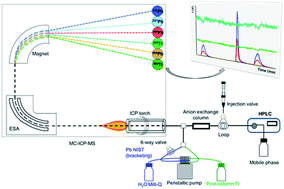Direct determination of Pb isotope ratios in archaeological materials by coupling liquid chromatography to multicollector ICP-MS†
Abstract
A procedure for the determination of Pb isotope ratios by coupling liquid chromatography to a multicollector ICP-MS has been developed. The procedure allows the direct injection of samples after dissolution without resorting to time-consuming off-line separation procedures. The separation of Pb from concomitant elements is carried out by anionic exchange as ethylenediamine tetraacetic acid (EDTA) chelates using EDTA and ammonium nitrate as a mobile phase. A flow injection system allows the injection of NIST 981 Pb isotopic standard, before and after the Pb peak from the sample, and the on-line addition of Tl for mass bias correction and bracketing. The procedure was validated by injecting NIST 981 into the chromatographic system and by comparing the results for real samples with the classical off-line separation procedure using Pb spec resins. The optimised procedure was applied to archaeological samples containing different concentrations of Pb. It was observed that the only limitation to the accuracy of the procedure was the concentration of Pb in the samples as no preconcentration is performed. Solid archaeological samples containing at least 500 μg g−1 of Pb can be studied using the proposed procedure.



 Please wait while we load your content...
Please wait while we load your content...